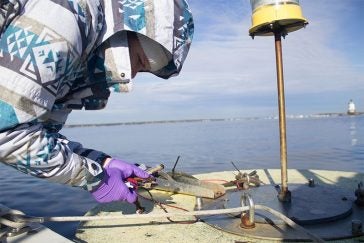
Passive samplers are monitoring tools that are deployed in air or water for a few weeks. They provide an average concentration of environmental contaminants, which is often more reliable than a one-time grab sample. Passive samplers have been widely used for many types of pollutants, such as heavy metals, pesticides, and other organic compounds, but until recently, a passive sampler has not existed for PFAS chemicals. For her MS research, STEEP trainee Christine Gardiner has helped to develop and validate a new passive sampler, which can be used to measure PFAS in drinking water reservoirs and act as a long-term monitoring tool for these contaminants.
For her project, Gardiner partnered with the Narragansett Bay Commission (NBC)—a state-funded, privately-run organization that operates the two largest wastewater treatment plants in Rhode Island—and the U.S. Environmental Protection Agency (EPA). She deployed samplers at NBC’s facilities which allowed her to use data they collect on effluent to validate the samplers. In turn, the NBC was provided with information on current wastewater PFAS levels, which had not previously been measured. With the EPA, she deployed passive samplers at nine long-term monitoring sites across Narragansett Bay to explore how the samplers work in the environment and compare the PFAS concentrations derived from the samplers to the EPA’s previously measured concentrations.

Gardiner’s thesis – “Evaluation of a novel passive sampler for poly- and perfluoroalkyl substances in aquatic environments” – describes how these results were used to address questions on different sampling strategies and inform how PFAS are introduced and spread in the environment. Further laboratory testing is being conducted on these samplers and once standardized, they will benefit countless monitoring efforts in aquatic environments, and aid in drinking water, fisheries, and industrial discharge applications.

